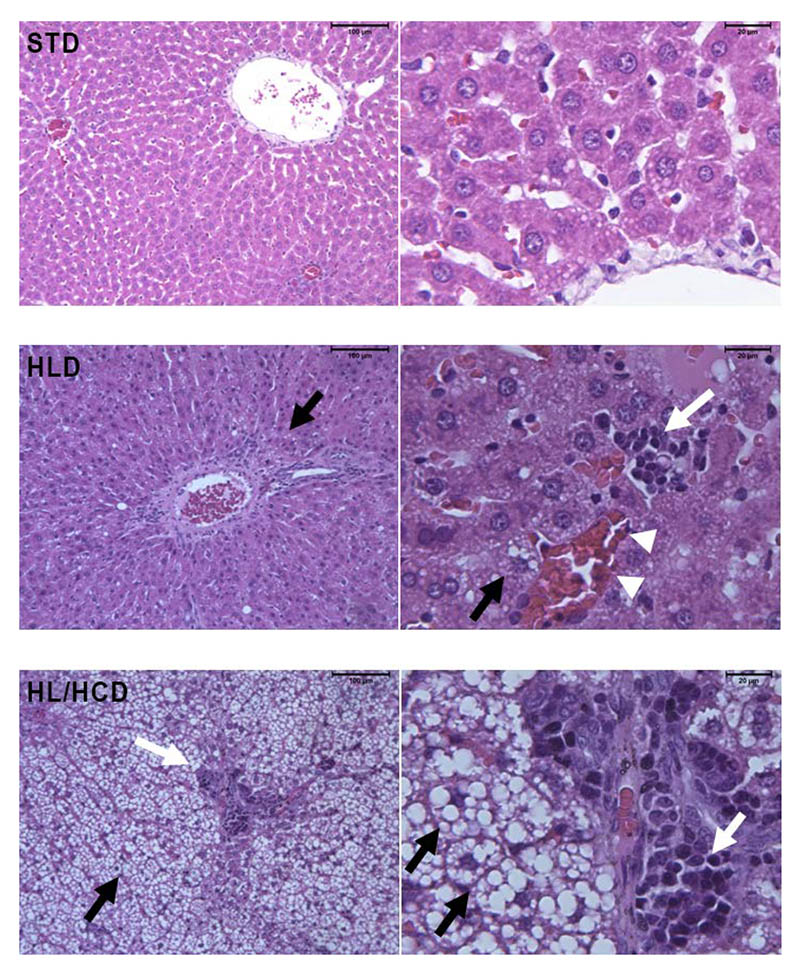Volume 113, Nº 5, November 2019
DOI: http://www.dx.doi.org/10.5935/abc.20190149
ORIGINAL ARTICLE
High-Lard and High-Cholesterol Diet, but not High-Lard Diet, Leads to Metabolic Disorders in a Modified Dyslipidemia Model
Lidiane B. Muniz
Aline M. Alves-Santos
Fabricio Camargo
Danieli Brolo Martins
Mara Rubia N. Celes
Maria Margareth V. Naves

Figure 1 – Morphological evaluation of the liver of Wistar rats fed high-fat diets for six weeks. STD (standard diet): preserved hepatic tissue architecture with conserved vascular distribution. HLD (high-lard diet): preserved hepatic tissue architecture with mild and uniform hepatic steatosis (black arrows), mild inflammatory infiltrate (white arrows), and mild passive hyperemia (arrowheads). HL/HCD (high-lard and high-cholesterol diet): altered tissue architecture with moderate hepatic steatosis, fat microvesicles and macrovesicles (black arrows), and marked inflammatory infiltrate (white arrows). The bars indicate 100 μm at 100x magnification (left panel) and 20 μm at 400x magnification (right panel).
Abstract
Background: In view of the increased global prevalence of cardiovascular and hepatic diseases, the diet lipid content and its relationship with the accumulation of fat in hepatocytes have been investigated as key factors in preventing these diseases. Objective: To evaluate the metabolic effects of a high-lard diet supplemented or not with cholesterol on a modified dyslipidemia model.
Methods: We divided 24 adult male Wistar rats into three groups: standard diet (STD - 4% lipids), high-lard diet (HLD - 21% lard), and high-lard and high-cholesterol diet (HL/HCD - 20% lard, 1% cholesterol, 0.1% cholic acid). After six weeks of treatment, blood and liver were collected for biochemical (serum lipid profile and liver enzymes) and morphological analyses. Statistical analysis included one-way analysis of variance (ANOVA), followed by Tukey test for mean comparisons, and a 5% probability was considered statistically significant.
Results: Animals fed HL/HCD showed increased total cholesterol, triacylglycerol, LDL-c, non-HDL-c, alanine aminotransferase (ALT), and aspartate aminotransferase (AST) serum levels compared to those fed STD. In addition, the HL/HCD animals presented higher relative liver weight, with moderate macrovesicular hepatic steatosis and inflammatory infiltrate.
Conclusion: A high-fat diet with lard (20%) and cholesterol (1%) triggered dyslipidemia with severe liver damage in rats in a shorter experimental time than the previously reported models. The high-lard diet without supplementation of cholesterol led to body weight gain, but not to dyslipidemia. (Arq Bras Cardiol. 2019; 113(5):896-902)
Keywords: Dietary Fats; Cholesterol; Lipid Metabolism; Fatty Liver; Inflammation; Rats.















